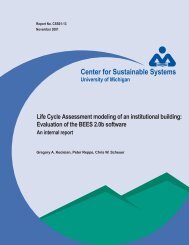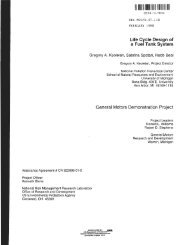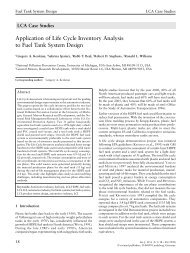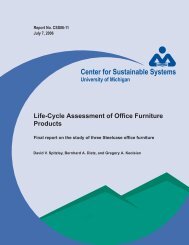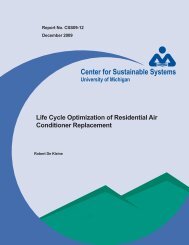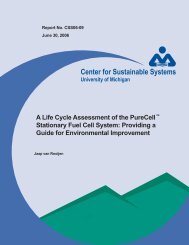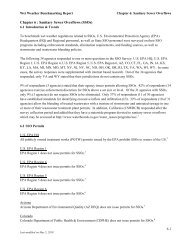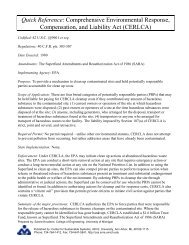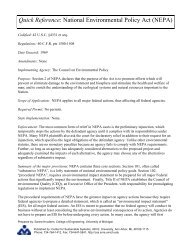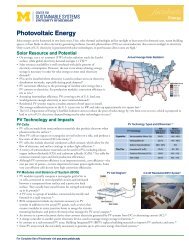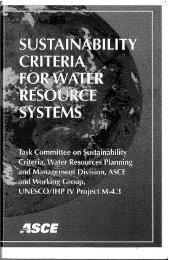Life cycle energy and environmental benefits of ge... - ResearchGate
Life cycle energy and environmental benefits of ge... - ResearchGate
Life cycle energy and environmental benefits of ge... - ResearchGate
You also want an ePaper? Increase the reach of your titles
YUMPU automatically turns print PDFs into web optimized ePapers that Google loves.
M.C. Heller et al. / Renewable Energy 29 (2004) 1023–10421039increase to 50 billion kWh by 2020, more than 700% above the Annual EnergyOutlook reference case. Adopting the goal <strong>of</strong> 20% RPS by 2020 is forecasted toincrease total biomass-fueled<strong>ge</strong>neration to 526 billion kWh by 2020, with 85% <strong>of</strong>this from dedicated power plants. Under this 20% RPS scenario, biomass composes10% <strong>of</strong> the total electricity <strong>ge</strong>neration [4].Establishing <strong>energy</strong> crops, <strong>of</strong> course, requires arable l<strong>and</strong>, <strong>and</strong> there is concernover the availability <strong>of</strong> this limited resource. According to our model, supplyin<strong>ge</strong>nough willow to support a 10% c<strong>of</strong>ire <strong>of</strong> all willow at the Dunkirk facility wouldrequire an estimated2925 ha <strong>of</strong> plantation. This is 2.5% <strong>of</strong> the open l<strong>and</strong>with suitablesoils <strong>and</strong> slopes for willow biomass production within an 83 km radius aroundthe Dunkirk plant (note that Dunkirk is on the shore <strong>of</strong> Lake Erie, so much <strong>of</strong> thearea aroundthe plant is unavailable) [34]. Operating a 100 MW gasifier at 37%efficiency <strong>and</strong>80% capacity wouldrequire 26,865 ha <strong>of</strong> willow plantation, or only1.3% <strong>of</strong> the total area within an 80 km radius. In an exp<strong>and</strong>ed biomass <strong>energy</strong>market, however, willow <strong>energy</strong> crops will be one <strong>of</strong> many biomass sources includingurban, agricultural, <strong>and</strong>forestry residues <strong>and</strong>other <strong>energy</strong> crops such asswitchgrass. A recent EIA report estimates that 3.9–5.8 million ha <strong>of</strong> <strong>energy</strong> cropswill be needed to meet the 20% RPS by 2020 projection [6]. The report also pointsout that it is possible to grow biomass <strong>energy</strong> crops on Conservation Reserve Program(CRP) l<strong>and</strong>, <strong>and</strong> that this projected <strong>energy</strong> crop acrea<strong>ge</strong> represents 24–37%<strong>of</strong> the current allowable CRP l<strong>and</strong>. In addition, acrea<strong>ge</strong> devoted to farms <strong>and</strong> rancheshas been declining steadily since the 1950s [35]. Thus, l<strong>and</strong>use for biomass<strong>energy</strong> crops is not expectedto conflict with l<strong>and</strong>requirements for food<strong>and</strong>feedcrop production.5. Conclusions<strong>Life</strong> <strong>cycle</strong> analysis demonstrates that electricity <strong>ge</strong>neration with willow <strong>energy</strong>crops, either by c<strong>of</strong>iring with coal or in dedicated biomass power plants, leads tosignificant reductions in many <strong>of</strong> the <strong>environmental</strong> impacts <strong>of</strong> coal-based electricityproduction. Consumption <strong>of</strong> non-renewable resources (coal) is reduced, asare net greenhouse gas emissions <strong>and</strong>criteria air pollutants including SO 2 , Hg, <strong>and</strong>likely, NO x . C<strong>of</strong>iring biomass at 10% increases the net <strong>energy</strong> ratio <strong>of</strong> producin<strong>ge</strong>lectricity by 8.9%. Similarly, the net <strong>energy</strong> ratio for dedicated biomass gasificationis estimated to be 13, indicating that 13 units <strong>of</strong> electricity are produced forevery unit <strong>of</strong> fossil <strong>energy</strong> consumedacross the entire system life <strong>cycle</strong>. For comparison,the net <strong>energy</strong> ratio <strong>of</strong> the current US electricity gridis 0.26.This study sug<strong>ge</strong>sts that the <strong>environmental</strong> impacts from producing electricitywith willow biomass <strong>energy</strong> crops are similar to using woody residues <strong>and</strong> that thepollution preventedis comparable to other renewable <strong>energy</strong> sources (solar <strong>and</strong>wind). Additional data <strong>and</strong> experience are needed to determine whether the smalldifferences reported here are indeed significant. It should be noted that choice <strong>of</strong>modeling parameters <strong>and</strong> allocation procedures can have significant effects onresults. <strong>Life</strong> <strong>cycle</strong> assessment basedon ISO 14040 guidelines <strong>of</strong>fers a validmeans <strong>of</strong>



